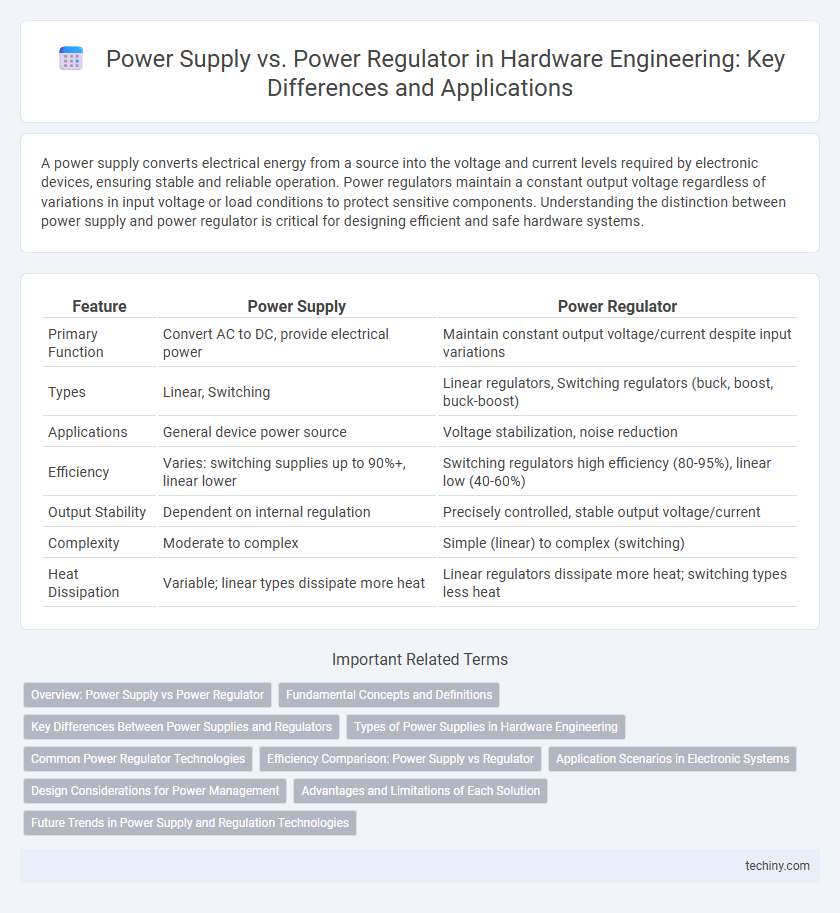A power supply converts electrical energy from a source into the voltage and current levels required by electronic devices, ensuring stable and reliable operation. Power regulators maintain a constant output voltage regardless of variations in input voltage or load conditions to protect sensitive components. Understanding the distinction between power supply and power regulator is critical for designing efficient and safe hardware systems.
Table of Comparison
| Feature | Power Supply | Power Regulator |
|---|---|---|
| Primary Function | Convert AC to DC, provide electrical power | Maintain constant output voltage/current despite input variations |
| Types | Linear, Switching | Linear regulators, Switching regulators (buck, boost, buck-boost) |
| Applications | General device power source | Voltage stabilization, noise reduction |
| Efficiency | Varies: switching supplies up to 90%+, linear lower | Switching regulators high efficiency (80-95%), linear low (40-60%) |
| Output Stability | Dependent on internal regulation | Precisely controlled, stable output voltage/current |
| Complexity | Moderate to complex | Simple (linear) to complex (switching) |
| Heat Dissipation | Variable; linear types dissipate more heat | Linear regulators dissipate more heat; switching types less heat |
Overview: Power Supply vs Power Regulator
Power supplies convert electrical energy from external sources into the required voltage and current for electronic devices, ensuring stable energy delivery. Power regulators maintain consistent voltage levels within circuits by adjusting fluctuations in electrical input, protecting sensitive components from damage. Both components are critical in hardware engineering for optimizing device performance and reliability.
Fundamental Concepts and Definitions
Power supply converts electrical energy from a source into the correct voltage and current to power a device. A power regulator maintains a steady output voltage or current despite variations in input voltage or load conditions. Understanding their fundamental roles is crucial for designing stable and efficient hardware systems.
Key Differences Between Power Supplies and Regulators
Power supplies convert AC voltage into a usable DC voltage, providing the initial source of electrical energy for electronic devices. Power regulators maintain a stable output voltage by adjusting fluctuations and load variations, ensuring consistent performance and protecting sensitive components. Unlike power supplies that deliver raw power, regulators refine and stabilize this power to meet precise operational requirements in hardware engineering.
Types of Power Supplies in Hardware Engineering
Linear power supplies and switching power supplies are the two main types of power supplies used in hardware engineering, each offering distinct advantages and applications. Linear power supplies provide clean, low-noise DC output suitable for sensitive analog circuits, while switching power supplies deliver higher efficiency and versatility, making them ideal for digital electronics and battery-powered devices. Understanding power regulators such as linear regulators and switching regulators is essential, as they control voltage levels within power supplies to ensure stable and reliable performance across various hardware components.
Common Power Regulator Technologies
Common power regulator technologies in hardware engineering include linear regulators, switching regulators, and low dropout (LDO) regulators, each offering different trade-offs in efficiency and noise performance. Linear regulators provide simple design and low noise but suffer from lower efficiency, while switching regulators excel in efficiency and power conversion for high-current applications despite increased complexity and electromagnetic interference. LDO regulators deliver precise voltage regulation with minimal dropout voltage, making them ideal for battery-powered devices requiring stable voltage under varying load conditions.
Efficiency Comparison: Power Supply vs Regulator
Power supplies convert electrical energy from a source to the correct voltage and current, often achieving efficiencies between 70% and 95%, depending on the type and design. Power regulators, specifically linear regulators, typically exhibit lower efficiency ranging from 30% to 60% due to energy dissipation as heat, while switching regulators can reach efficiency levels comparable to power supplies by rapidly switching on and off. Evaluating efficiency between power supplies and regulators requires considering application-specific factors such as load conditions, thermal management, and output stability.
Application Scenarios in Electronic Systems
Power supplies provide the initial conversion and delivery of electrical energy from the main source to electronic systems, ensuring stable voltage levels suitable for general operation. Power regulators are essential in fine-tuning and maintaining precise voltage outputs within devices, protecting sensitive components from voltage fluctuations and ensuring consistent performance. In complex electronic systems, power supplies handle bulk energy transformation, while power regulators manage voltage stability for microprocessors, sensors, and communication modules.
Design Considerations for Power Management
Power supply design focuses on delivering stable voltage and current levels from an external source, requiring considerations for efficiency, thermal management, and input compatibility. Power regulators demand precise voltage control, low dropout performance, and minimal noise generation to protect sensitive components and ensure system reliability. Effective power management integrates both elements to optimize energy distribution, reduce electromagnetic interference, and extend device lifespan.
Advantages and Limitations of Each Solution
Power supplies provide a stable voltage output by converting AC to DC with high efficiency, suitable for delivering consistent power to devices but often occupying more space and generating heat. Power regulators control voltage levels with precision and fast response time, ideal for sensitive electronics but can introduce power losses and require additional components for effective heat dissipation. Each solution balances efficiency, size, and thermal management depending on the application's specific power quality and stability requirements.
Future Trends in Power Supply and Regulation Technologies
Emerging power supply and regulation technologies emphasize energy efficiency, compact size, and smart adaptability to support increasingly complex hardware systems. Advancements in GaN (Gallium Nitride) and SiC (Silicon Carbide) semiconductor materials enable higher switching frequencies and reduced power losses, driving the next generation of power regulators. Integration of IoT-enabled intelligent management systems and AI-driven predictive analytics optimizes real-time power distribution and thermal performance in modern hardware engineering applications.
power supply vs power regulator Infographic

 techiny.com
techiny.com